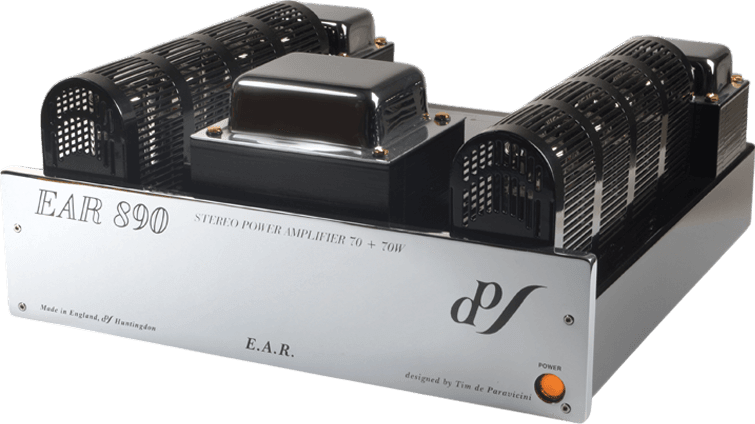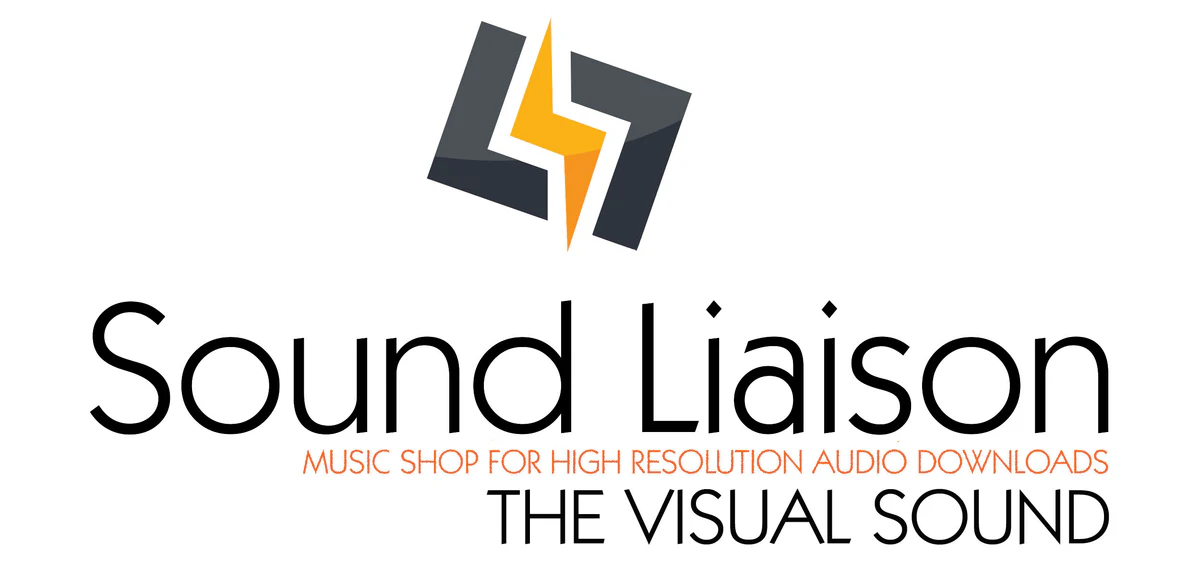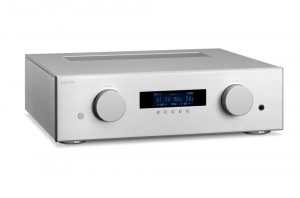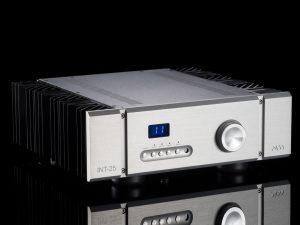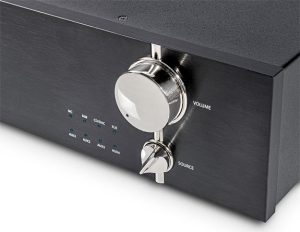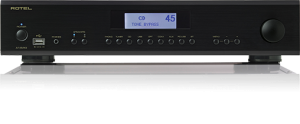This article by Francisco Duran and Ed Morawski originally ran in Issue 8, August/September 2003, so while we call this section "New Old Stock - Articles from Our Days in Print" you are also going to see some articles from our early days of going online.

The Sophia Baby is a cute little (7 x 9 x 5-inch) integrated tube amp that you can almost hold in the palm of your hand. When you see it, you want to keep it, just because. The Baby is a class A, 10-watt stereo, push-pull design weighing a whopping 20 pounds. The tube complement consists of four 6P1T Russian military power tubes and two 5670 input and driver tubes. The 5670s are specified as NOS USA on the spec sheet. The frequency, signal-to-noise, and distortion figures are very respectable for a low-cost tube amp, a fact Sophia stresses on their website. This Baby may be small, but it ain't no toy.
The Baby has a black textured metal chassis with silver metal and wood accents. Its appearance reminds me very much of the Unison Research amps of Italy. There is only one set of inputs around back, next to the only set of outputs, the speaker posts, and the IEC connector. The front panel is also sparse, with only an on/off toggle switch and a gold volume knob. If you are looking for a way to simplify your system, here it is.
You are probably thinking that the Baby could see duty in a den or office, but how about as a high-quality replacement for that sterile, grainy-sounding, solid state amp that you've been meaning to sell? Of course, the Baby should be mated with efficient speakers—after all, ten watts is ten watts—but those ten watts did very well driving both my ProAc Response Twos and my Spendor 2/3s, which are rated at 87 and 88dB respectively, not to mention a review pair of Zu Druid speakers rated at 101dB. The Baby was quiet as a mouse with all of these speakers. The hum measurement in the spec sheet reads: "Not measurable (less than 0.3 MV)," and the S/N measurement is claimed to be –95dB. These claims were backed up by what I heard.
After going over its measurements and marveling at its size, the next step with this infant was to have some fun. The Baby turned in a pretty good musical performance. Music was very clean, detailed, and fast paced. My usual battery of orchestral works moved along quite nicely. There was more than a fair amount of depth and width. Though the soundstage was not as spacious as with my Antique Sound mono amps or the big Canary 300B amp, it was satisfying nonetheless.
The Baby is linear and has clean transients. It was less full and warm sounding than either my Antique Sound Labs monoblocks or the Armonia Nightingale and Acoustic Masterpiece AM-201 amps that I had in house at the time. These transients were heard to good effect on cleanly recorded acoustic guitar CDs, like my Ana Caram discs on the Chesky label. Her voice was also crisp and clear, if not quite as full as I am accustomed to hearing. On my Doug MacLeod discs, the electric and acoustic guitars were reproduced cleanly and with very fine detail, and there was no slurring of bass notes. The tone and texture of the music was there, and sounded more realistic than what I hear from a lot of solid state amps. Although the Baby is definitely in the "lean and clean" camp, it reveals enough of its tube pedigree to give the music fullness and body. I also felt that the tonal color of the music was better reproduced than through most solid state amps.
One look at the Baby and you can see that most of the weight is in those hefty transformers at the back of the chassis. Although the Baby did a reasonable job driving the speakers that I had on hand, when I switched back to my ASL monoblocks I quickly noticed a fullness, openness, and sense of ease that was not quite there with the smaller, less powerful amp. Dynamic shadings took on a more vividness, and there was more heft and dynamic bloom in the bass. Nevertheless, let's not ignore the price and power output of the Sophia amp. I don't want to look like I'm picking on a little baby for not having the dynamics of its bigger cousins!
While the Baby would work well in an office or den system, it would also be a great choice for anchoring down those expensive, super-efficient horns that you just blew all of your money on, leaving only six or seven bills for an amp. With the Baby, you wouldn't have to worry about hum or extraneous noise. The Baby is dead quiet. It is also musical and a heck of a lot of fun. I found myself slipping into the music and forgetting the review process more often than not. There are other choices in its category, like the GW Labs Cyclops or the Antique Sound Labs MGSI15DT, but if the Sophia Baby's sonic character and ergonomics fit your system and taste, you can add it to your audition list with confidence. Francisco Duran
Here's a perfect example of why it sometimes pays to be a reviewer. Normally, I would not have given the Sophia Electric Music Baby amplifier a second glance, but when Francisco Duran of Positive Feedback dropped off this little gem for audition, I discovered a giant in baby's clothes.
The Sophia is a ten-watt Class A single-ended triode amplifier with a complement of four Russian military 6P1T output tubes and two NOS 5670s for inputs. It comes in a basic package, but you can specify a variety of cosmetic and sonic upgrades. It appears to be well made, and during the time I had it there were no problems or glitches of any kind.
Let me get some nitpicking out of the way. One of the available upgrades is better WBT binding posts. Go for them, as the stock ones are marginal. You can also specify Black Gate or oil-filled caps, and those might be very worthwhile. Also, while the on/off switch works fine, it is a bit cheesy, especially since it's right next to a beautiful gold volume control knob (another plus, by the way).
Because of that little volume control, you don't need a preamp if you've only got one source.
I did try the Baby with my E.A.R. 864 preamp, and it worked well that way, but for most of my listening I connected my Accuphase DP-65V directly to the Sophia with Empirical Audio's PC Interconnects. It was a most satisfying experience. With efficient speakers (like the ZU Druids—see review elsewhere), the Baby fills the room with music, at volumes that could make the neighbors come running. With speakers of normal sensitivity, it still does a credible job, at least in a small room like mine. Never in the weeks I had the Sophia did I wish for more power.
The Sophia Music Baby is an incredible value. You can spend ten times as much, but I'm not sure you'll get ten times better sound. The Baby is musical, smooth, and kind of dreamy in its portrayal of music, especially acoustic music. Voices were rendered with a lushness that belied the Sophia's tiny size. I know that the solid state guys out there groan about "tube distortion," and they're right, nor will the Baby's ten watts shake the house with pounding bass, but if you crave detail, resolution, smoothness, cymbals that sound like cymbals, guitar strings that vibrate and flutter, and horns that positively sing, tubes are the way to go, and you couldn't ask for a much better tube amp than the Music Baby, especially at its price. Perhaps the lush sound of the Baby comes from its wide frequency range (6 to 80,000 Hz +/-3dB!). Or it's impressive -95dB signal-to-noise ratio, which make it possible to drive 112 dB horn speakers without noise. I heard NOTHING from the Sophia but music—no hum, no "tube rush," no noise of any kind.
If you listen to jazz, bluegrass, acoustic, or vocal music, live in a small apartment or condo, or just like your listening experience to be intimate, the Sophia Music Baby should be high on your audition list. It could be a truly wonderful entry into the world of tube sound, the basis of a small but high-quality audiophile system, or just a fun alternative to pull out when you're tired of solid state sound. Just match your Sophia carefully to some efficient speakers, connect your vinyl rig or CD player, and sit back and enjoy. Ed Morawski
Baby integrated
Retail: $899





